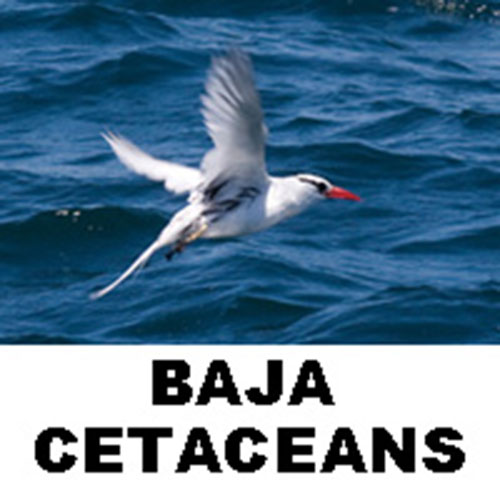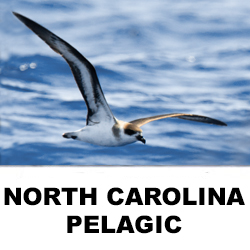|
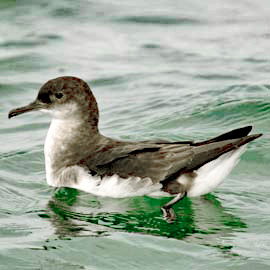 A new trip in 2007 based on repositioning of Heritage Expeditions ship from New Zealand waters to Arctic regions, the actual voyage being
from North Island, New Zealand, to Soutern Japan. A specialist trip for seabirds and island endemics, I was fortunate to be able to join this first trip
and in so doing, encountered some fourteen new (to me) seabirds, most of which would otherwise be very difficult or impossible to observe.
This included some rarely observed species such as Heinroth's Shearwater and Collared Petrel, we claimed the first records of the latter for Australian
Waters, obviously subject to acceptance. Read on if you don't mind being gripped off!
A new trip in 2007 based on repositioning of Heritage Expeditions ship from New Zealand waters to Arctic regions, the actual voyage being
from North Island, New Zealand, to Soutern Japan. A specialist trip for seabirds and island endemics, I was fortunate to be able to join this first trip
and in so doing, encountered some fourteen new (to me) seabirds, most of which would otherwise be very difficult or impossible to observe.
This included some rarely observed species such as Heinroth's Shearwater and Collared Petrel, we claimed the first records of the latter for Australian
Waters, obviously subject to acceptance. Read on if you don't mind being gripped off!
The trip sailed from Auckland, but I must mention first the pelagic trip in the Hauraki Gulf which took place the previous day.
If going on the trip I would suggest also doing the pelagic for two reasons, firstly the main target species is the recently rediscovered
New Zealand Storm-petrel, although the main trip spends time in the area sightings are virtually guaranteed on the pelagic, however I understand trips from
2008 on will spend more time in the Gulf. The second reason is that it means you arrive in New Zealand with time in hand should there be any delays, although
some people will probably come out early anyway if they haven't been to the country previously. Missing the boat on this trip is not recommended!
The pelagic boats had to go some distance out at this time of year to connect with the storm-petrels, as we progressed we saw
Little Blue Penguins and Fluttering Shearwaters. quite close to the boat. In fact the shearwaters were in
quite large flocks, as were their relatives Buller's Shearwaters. We eventually arrived, after a somewhat rough ride, in the outer
area of the Gulf and duly saw up to four New Zealand Storm-petrels. We had lunch in the lee of a stack which holds a colony of
Grey Ternlets. Formerly included within Blue-Grey Noddy, many authorities now accept them as a different species, and this is their only breeding
area in New Zealand.
 Being a real enthusiasts trip, many of us left our hotel after dinner to do a bit of owling, being rewarded with good views of a Morepork. An added bonus
was a number of Cook's Petrels passing over the hotel at dusk, returning to a nearby colony. Our New Zealand guides who were to
accompany us the next day helped us identify these, as most of us just didn't realise what we were seeing, not expecting Pterodromas to be flying overland!
The voyage proper was to begin the next day in the evening, so Wildwings, as they so often do, organised some entertainment in the form of a little local
birding. The highlight was a visit to the world-famous Miranda Shorebird Centre, although many people had been there before it was still a worthwhile
experience, particularly as a long-staying Hudsonian Godwit was present, just coming in to breeding plumage. Other birds included
Wrybills, New Zealand Dotterels, three Sharp-tailed Sandpipers, a
Greater Sandplover, Double-banded Dotterel and Red-necked Stints.
Being a real enthusiasts trip, many of us left our hotel after dinner to do a bit of owling, being rewarded with good views of a Morepork. An added bonus
was a number of Cook's Petrels passing over the hotel at dusk, returning to a nearby colony. Our New Zealand guides who were to
accompany us the next day helped us identify these, as most of us just didn't realise what we were seeing, not expecting Pterodromas to be flying overland!
The voyage proper was to begin the next day in the evening, so Wildwings, as they so often do, organised some entertainment in the form of a little local
birding. The highlight was a visit to the world-famous Miranda Shorebird Centre, although many people had been there before it was still a worthwhile
experience, particularly as a long-staying Hudsonian Godwit was present, just coming in to breeding plumage. Other birds included
Wrybills, New Zealand Dotterels, three Sharp-tailed Sandpipers, a
Greater Sandplover, Double-banded Dotterel and Red-necked Stints.
 We set sail in the evening, and arrived off Great Barrier Island at dawn, from where we "milled around" looking for seabirds. Probably the most numerous were
Black (Parkinson's) Petrels, and numbers of Flesh-footed Shearwaters enabled comparisons to be made between these two
outwardly similar species. Seen well they are quite different, and as both species are attracted to ships this was easily achieved. For those who hadn't been
on the pelagic there were good views of Buller's Shearwater, and as we headed for the Mokohinau Islands for the ternlets we also saw
Australasian Gannets, nearly all adult strangely, a few Common Diving Petrels and a number of Cook's Petrels. Some of these may have been
Pycroft's Petrels, since the Hauraki Gulf is their stronghold, but the rule seems to be "Cook's until proven Pycroft's" as identification is very difficult,
and Pycroft's are outnumbered by a ratio of about a hundred to one. All this before breakfast!
We couldn't approach the stacks too closely, unlike the pelagic boat two days before, but everyone got reasonable views of Grey Ternlets, and the ship soon
moved towards the New Zealand Storm-petrel area where the lucky ones had scored previously. Right on cue a stormie appeared- Wilson's!
Soon after two of the target species flew past fairly distantly, but most people missed them. We began chumming, but the only new species were a few
Fairy Prions. Lunch was one of those strange affairs in birding where part of the group are becoming increasingly desperate, and
others are relaxed because the pressure's off! However, our meal passed smoothly and everyone resolved to keep looking.
We set sail in the evening, and arrived off Great Barrier Island at dawn, from where we "milled around" looking for seabirds. Probably the most numerous were
Black (Parkinson's) Petrels, and numbers of Flesh-footed Shearwaters enabled comparisons to be made between these two
outwardly similar species. Seen well they are quite different, and as both species are attracted to ships this was easily achieved. For those who hadn't been
on the pelagic there were good views of Buller's Shearwater, and as we headed for the Mokohinau Islands for the ternlets we also saw
Australasian Gannets, nearly all adult strangely, a few Common Diving Petrels and a number of Cook's Petrels. Some of these may have been
Pycroft's Petrels, since the Hauraki Gulf is their stronghold, but the rule seems to be "Cook's until proven Pycroft's" as identification is very difficult,
and Pycroft's are outnumbered by a ratio of about a hundred to one. All this before breakfast!
We couldn't approach the stacks too closely, unlike the pelagic boat two days before, but everyone got reasonable views of Grey Ternlets, and the ship soon
moved towards the New Zealand Storm-petrel area where the lucky ones had scored previously. Right on cue a stormie appeared- Wilson's!
Soon after two of the target species flew past fairly distantly, but most people missed them. We began chumming, but the only new species were a few
Fairy Prions. Lunch was one of those strange affairs in birding where part of the group are becoming increasingly desperate, and
others are relaxed because the pressure's off! However, our meal passed smoothly and everyone resolved to keep looking.
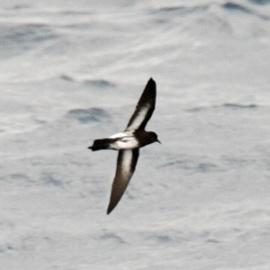 We decided to try another area after lunch, on the edge of the 200 metre depth line
towards the Poor Knights Islands. This would be our last chance before sailing North. Before too long we were in position and
started chumming again, some started praying, and Chris Collins, the principle leader and who really was largely instrumental
in setting up the trip, just worried. Not for long though, as two New Zealand Storm-petrels soon appeared over the chum slick.
Views were short-lived, as slick and ship were drifting apart. However, one of the plus factors of such voyages is that the ship can deviate from it's course to
follow wildlife, and we duly circled back to the chum where everyone got good views. Just before leaving the area a Campbell Albatross
circled the ship a few times and landed on the water right beside us, we had hoped for more albatrosses but they tend to occur further South. Later in
the afternoon a Gibson's Wandering Albatross circled once at some distance. Just to prove why New Zealand is called the "seabird
capital of the world" the day at various times produced another seven species, although not all seen by everybody. It didn't matter, all except
White-faced Storm-petrel and Pycroft's Petrel were seen later in the voyage and usually better. It turned out that, over the voyage
as a whole, with only one or two exceptions, most species were seen
over a period of two or three days in good numbers, depending on where their breeding stations were. This meant that, if you missed something, it would be
likely to be seen again. Unfortunately this didn't apply to everything, there was only the one sighting of Pycroft's Petrel which tends to occur only
in this area, fairly late in the afternoon.
I have to say that not everybody was convinced by the identification of this bird, given the similarity to Cook's, but it was called
by Phil Hansboro who was able to observe and point out all the subtle features which separate the two, the bird showing well enough for long enough to make this
possible. Phil is an expatriate living in Australia and is a seabird expert, helping to organise the pelagics out of Woollogong. We decided to try another area after lunch, on the edge of the 200 metre depth line
towards the Poor Knights Islands. This would be our last chance before sailing North. Before too long we were in position and
started chumming again, some started praying, and Chris Collins, the principle leader and who really was largely instrumental
in setting up the trip, just worried. Not for long though, as two New Zealand Storm-petrels soon appeared over the chum slick.
Views were short-lived, as slick and ship were drifting apart. However, one of the plus factors of such voyages is that the ship can deviate from it's course to
follow wildlife, and we duly circled back to the chum where everyone got good views. Just before leaving the area a Campbell Albatross
circled the ship a few times and landed on the water right beside us, we had hoped for more albatrosses but they tend to occur further South. Later in
the afternoon a Gibson's Wandering Albatross circled once at some distance. Just to prove why New Zealand is called the "seabird
capital of the world" the day at various times produced another seven species, although not all seen by everybody. It didn't matter, all except
White-faced Storm-petrel and Pycroft's Petrel were seen later in the voyage and usually better. It turned out that, over the voyage
as a whole, with only one or two exceptions, most species were seen
over a period of two or three days in good numbers, depending on where their breeding stations were. This meant that, if you missed something, it would be
likely to be seen again. Unfortunately this didn't apply to everything, there was only the one sighting of Pycroft's Petrel which tends to occur only
in this area, fairly late in the afternoon.
I have to say that not everybody was convinced by the identification of this bird, given the similarity to Cook's, but it was called
by Phil Hansboro who was able to observe and point out all the subtle features which separate the two, the bird showing well enough for long enough to make this
possible. Phil is an expatriate living in Australia and is a seabird expert, helping to organise the pelagics out of Woollogong.
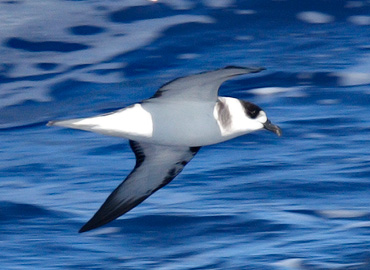 We had a two-day sail to the next landing, on Norfolk Island. Unusually for these waters, we awoke to a storm which was severe enough that most people stayed
in their cabins and the open decks were closed. As I had been lucky with my target species thus far, and had already been ill on the pelagic between trying to
photograph the stormies, I did the same, but things started to subside in the late afternoon and this and the next day were spent enjoying some of the best
seawatching in the world. Forget views half a mile away, whilst many species are not attracted to ships most don't avoid them either, particularly smaller
vessels such as ours, and some great views and photos were obtained. Species included
Sooty Shearwater, Grey-faced Petrels,
Kermadec Petrels, Black-winged Petrels, and the superb
White-necked Petrels, in addition to species seen previously. Towards the afternoon of the second day temperatures began to get much
warmer and species became more tropical in nature. Wedge-tailed Shearwaters, began to replace Buller's and Flesh-footed, and a couple
of Little Shearwaters (haurakinensis), appeared, in addition to the first Gould's Petrels, (probably of the
rare nominate race). Real tropical flavour was added by Red-tailed Tropicbirds, and White and
Sooty Terns. On a personal front, I managed to miss three Providence Petrels, a little worrying since we
were already north of their natal islands and they do seem to keep well away from ships. I did manage to catch up after Norfolk Island however.
We had a two-day sail to the next landing, on Norfolk Island. Unusually for these waters, we awoke to a storm which was severe enough that most people stayed
in their cabins and the open decks were closed. As I had been lucky with my target species thus far, and had already been ill on the pelagic between trying to
photograph the stormies, I did the same, but things started to subside in the late afternoon and this and the next day were spent enjoying some of the best
seawatching in the world. Forget views half a mile away, whilst many species are not attracted to ships most don't avoid them either, particularly smaller
vessels such as ours, and some great views and photos were obtained. Species included
Sooty Shearwater, Grey-faced Petrels,
Kermadec Petrels, Black-winged Petrels, and the superb
White-necked Petrels, in addition to species seen previously. Towards the afternoon of the second day temperatures began to get much
warmer and species became more tropical in nature. Wedge-tailed Shearwaters, began to replace Buller's and Flesh-footed, and a couple
of Little Shearwaters (haurakinensis), appeared, in addition to the first Gould's Petrels, (probably of the
rare nominate race). Real tropical flavour was added by Red-tailed Tropicbirds, and White and
Sooty Terns. On a personal front, I managed to miss three Providence Petrels, a little worrying since we
were already north of their natal islands and they do seem to keep well away from ships. I did manage to catch up after Norfolk Island however.
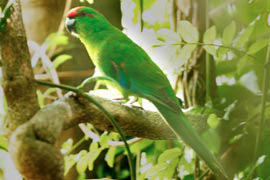 The following morning saw us landing on Norfolk Island, which is Australian Territory, although whether its four endemics are counted by Australian
listers I don't know. The first, Norfolk Island Parakeet, which has been split from Red-fronted of the mainland, is the subject
of a captive breeding program. As such it is readily seen because the aviary in the Botanical Gardens, which is most people's first port of call, usually
attracts wild birds; there are always one or two around.
Two of the other three endemics, Grey Gerygone and Slender-billed White-eye, are also easily seen in the
valley surrounding the gardens, everybody had seen them by lunchtime.
Most other birds seen were of island races,
Scarlet Robin, Grey Fantail, Emerald Dove and Golden Whistler.
The last two in particular are potential splits, especially the Whistler in which the male never attains the bright colouration of the mainland bird,
but remains drab and similar to the female. Since our return the dove has been split to become Australian Emerald Dove, distinct from the Asian taxa, the
island birds are still part of the species occuring on the mainland. Lunch was taken at the home of one of the local residents who has a keen interest in birds. Her property
must be one of the most amazing in the world, on a clifftop overlooking a scenic bay. Wedge-tailed Shearwaters nest under the house (the TV has to be
turned up at night to compete!), Black-winged Petrels breed in the garden, and Masked Boobies on the edge of the lawn! For good measure
Pacific Golden Plovers play at being Cattle Egrets in the paddock, and Red-tailed Tropicbirds drift overhead,
plus we saw a Nankeen Kestrel hovering above the cliff edge, and Australasian Gannets plunge-diving. Whilst we were there
a Black-winged Petrel flew several circuits of the garden, often close enough to hear the rush of air over its wings. How many people see Pterodromas
like that!
After lunch the group split, one half to view some of the seabird colonies for which the island is renowned, the other, which included
most of the serious observers, to look for the last endemic,
White-breasted White-eye. Despite my enthusiasm for seabirds I was tempted to join the latter group, and wish I hadn't. The White-eye
is probably extinct, but several sightings have been claimed in recent years, and we thought, given the number and calibre of observers, there was a chance to
"re-discover" it. All we got was a brief sighting of a bird in a flock, not seen by most, and a lot of controversy. The problem is that, although the bird
looked like the few illustrations we had, Silvereyes also occur on the island and some have very orangey flanks, which is a feature of White-breasted. To my
mind the white on the underparts was far too bright for a Silvereye, but some disagreed, most didn't see it, and views were just too brief to be positive.
So if you're thinking of doing this trip, the challenge is still there!, or not!
The following morning saw us landing on Norfolk Island, which is Australian Territory, although whether its four endemics are counted by Australian
listers I don't know. The first, Norfolk Island Parakeet, which has been split from Red-fronted of the mainland, is the subject
of a captive breeding program. As such it is readily seen because the aviary in the Botanical Gardens, which is most people's first port of call, usually
attracts wild birds; there are always one or two around.
Two of the other three endemics, Grey Gerygone and Slender-billed White-eye, are also easily seen in the
valley surrounding the gardens, everybody had seen them by lunchtime.
Most other birds seen were of island races,
Scarlet Robin, Grey Fantail, Emerald Dove and Golden Whistler.
The last two in particular are potential splits, especially the Whistler in which the male never attains the bright colouration of the mainland bird,
but remains drab and similar to the female. Since our return the dove has been split to become Australian Emerald Dove, distinct from the Asian taxa, the
island birds are still part of the species occuring on the mainland. Lunch was taken at the home of one of the local residents who has a keen interest in birds. Her property
must be one of the most amazing in the world, on a clifftop overlooking a scenic bay. Wedge-tailed Shearwaters nest under the house (the TV has to be
turned up at night to compete!), Black-winged Petrels breed in the garden, and Masked Boobies on the edge of the lawn! For good measure
Pacific Golden Plovers play at being Cattle Egrets in the paddock, and Red-tailed Tropicbirds drift overhead,
plus we saw a Nankeen Kestrel hovering above the cliff edge, and Australasian Gannets plunge-diving. Whilst we were there
a Black-winged Petrel flew several circuits of the garden, often close enough to hear the rush of air over its wings. How many people see Pterodromas
like that!
After lunch the group split, one half to view some of the seabird colonies for which the island is renowned, the other, which included
most of the serious observers, to look for the last endemic,
White-breasted White-eye. Despite my enthusiasm for seabirds I was tempted to join the latter group, and wish I hadn't. The White-eye
is probably extinct, but several sightings have been claimed in recent years, and we thought, given the number and calibre of observers, there was a chance to
"re-discover" it. All we got was a brief sighting of a bird in a flock, not seen by most, and a lot of controversy. The problem is that, although the bird
looked like the few illustrations we had, Silvereyes also occur on the island and some have very orangey flanks, which is a feature of White-breasted. To my
mind the white on the underparts was far too bright for a Silvereye, but some disagreed, most didn't see it, and views were just too brief to be positive.
So if you're thinking of doing this trip, the challenge is still there!, or not!
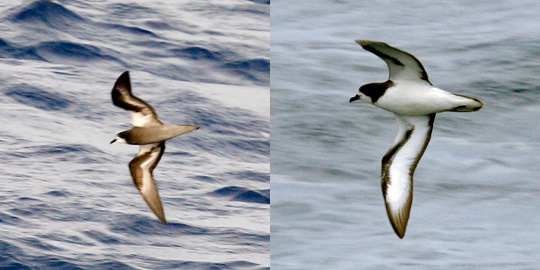 Sailing on from the island we then had about an hour and a half of daylight, followed by almost two days at sea before arriving at Noumea, the capital
of New Caledonia. Nothing new was seen in the evening, although plenty of seabirds were in evidence, including three Little Shearwaters. The following day
the seas were calmer and temperatures were beginning to rise, so most people were up before breakfast to see what turned out to be the best of the day's
action. Tahiti Petrels were the first new birds, most fairly distant, and plenty of Gould's Petrels much nearer. Then a dark-morph
Collared Petrel flew right under the bows, enabling good photos to be taken. This was apparently the second record for Australian
waters. This particular form has, since our return, been proposed as a "new" species, Magnificent Petrel, it certainly looks different with features that would
probably not occur on a "normal" dark phase bird. However the IOC accept it as a subspecies only at present.
Plenty of birds were in evidence all day, including three Kermadec and a Providence Petrel (which I finally caught up with), a
Brown Booby and a couple of White-tailed Tropicbirds. Flying with one of the Kermadec Petrels was
what appeared to be a small, short-winged Tahiti-type Petrel. This raised the possibility of its being the enigmatic Beck's Petrel, but as the only known
identification criteria are a 15% difference in size and a slight difference in bill shape we couldn't really take it any further, it didn't come close
enough for even a record shot. However, when the species was rediscovered later that year it was in exactly the same area.
Other species were no longer in evidence, we had seen our last Black Petrels and Grey-faced Petrels for instance, and as
the afternoon wore on birds became scarce. We did record our first cetaceans however, a group of Short-finned Pilot Whales.
Sailing on from the island we then had about an hour and a half of daylight, followed by almost two days at sea before arriving at Noumea, the capital
of New Caledonia. Nothing new was seen in the evening, although plenty of seabirds were in evidence, including three Little Shearwaters. The following day
the seas were calmer and temperatures were beginning to rise, so most people were up before breakfast to see what turned out to be the best of the day's
action. Tahiti Petrels were the first new birds, most fairly distant, and plenty of Gould's Petrels much nearer. Then a dark-morph
Collared Petrel flew right under the bows, enabling good photos to be taken. This was apparently the second record for Australian
waters. This particular form has, since our return, been proposed as a "new" species, Magnificent Petrel, it certainly looks different with features that would
probably not occur on a "normal" dark phase bird. However the IOC accept it as a subspecies only at present.
Plenty of birds were in evidence all day, including three Kermadec and a Providence Petrel (which I finally caught up with), a
Brown Booby and a couple of White-tailed Tropicbirds. Flying with one of the Kermadec Petrels was
what appeared to be a small, short-winged Tahiti-type Petrel. This raised the possibility of its being the enigmatic Beck's Petrel, but as the only known
identification criteria are a 15% difference in size and a slight difference in bill shape we couldn't really take it any further, it didn't come close
enough for even a record shot. However, when the species was rediscovered later that year it was in exactly the same area.
Other species were no longer in evidence, we had seen our last Black Petrels and Grey-faced Petrels for instance, and as
the afternoon wore on birds became scarce. We did record our first cetaceans however, a group of Short-finned Pilot Whales.
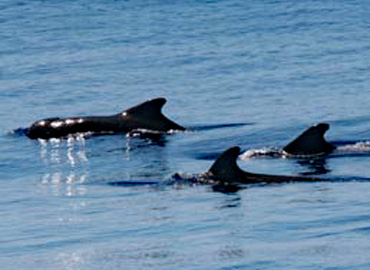 The following day we were to land on New Caledonia, and seabirds were similar to the previous day, with a couple of new species for good measure.
Numbers of Gould's Petrels increased,
not surprising as they breed on New Caledonia, presumably we were now seeing the form caledonica rather than the nominate. Some hundreds were seen,
several coming very close to the ship.
Large numbers of Wedge-tailed Shearwaters were around also, all dark morph. Red-footed Booby was new, and seen well, but the other
new birds were one of the target species for the trip, and caused our next round of controversy. Two or three Polynesian Storm-petrels
were seen distantly, all dark phase birds, not everybody saw them, and unless you got on them straight away identification was
very difficult. I was fairly happy with at least one bird as I picked it up at the same time it was called, although the views weren't really tickable. Thankfully
more were seen later, although it proved to be one of the more difficult species of the trip, particularly it terms of everyone getting good views.
Soon after this excitement we arrived in Noumea harbour, as we passed the outer reef flocks of Sooty or Short-tailed Shearwaters were seen (more controversy!)
and Silver Gulls and Swift (Great Crested) Terns patrolled the inner harbour. We were due for an early start
the next day to look for several endemics, although one, Dark-brown Honeyeater, was seen from the boat, a pair in a bush next to the
customs house.
Unfortunately it had by now started raining. Although at 4.00am the next day it wasn't, by the time the bus left at 5.00 it had started
again, and continued for most of the two days of our visit. This was not unexpected, as the island is one of the wettest in the Pacific, and it probably didn't
cost us too many birds. The big target was obviously Kagu, and thanks to the efforts of Yves and Jean-Marc, our guides, this was
achieved quite easily. Yves has almost single-handedly saved the Kagu from extinction, whilst Jean-Marc is taking over his job when he can finally be
persuaded to retire, so between them we had the best help available.
The following day we were to land on New Caledonia, and seabirds were similar to the previous day, with a couple of new species for good measure.
Numbers of Gould's Petrels increased,
not surprising as they breed on New Caledonia, presumably we were now seeing the form caledonica rather than the nominate. Some hundreds were seen,
several coming very close to the ship.
Large numbers of Wedge-tailed Shearwaters were around also, all dark morph. Red-footed Booby was new, and seen well, but the other
new birds were one of the target species for the trip, and caused our next round of controversy. Two or three Polynesian Storm-petrels
were seen distantly, all dark phase birds, not everybody saw them, and unless you got on them straight away identification was
very difficult. I was fairly happy with at least one bird as I picked it up at the same time it was called, although the views weren't really tickable. Thankfully
more were seen later, although it proved to be one of the more difficult species of the trip, particularly it terms of everyone getting good views.
Soon after this excitement we arrived in Noumea harbour, as we passed the outer reef flocks of Sooty or Short-tailed Shearwaters were seen (more controversy!)
and Silver Gulls and Swift (Great Crested) Terns patrolled the inner harbour. We were due for an early start
the next day to look for several endemics, although one, Dark-brown Honeyeater, was seen from the boat, a pair in a bush next to the
customs house.
Unfortunately it had by now started raining. Although at 4.00am the next day it wasn't, by the time the bus left at 5.00 it had started
again, and continued for most of the two days of our visit. This was not unexpected, as the island is one of the wettest in the Pacific, and it probably didn't
cost us too many birds. The big target was obviously Kagu, and thanks to the efforts of Yves and Jean-Marc, our guides, this was
achieved quite easily. Yves has almost single-handedly saved the Kagu from extinction, whilst Jean-Marc is taking over his job when he can finally be
persuaded to retire, so between them we had the best help available.
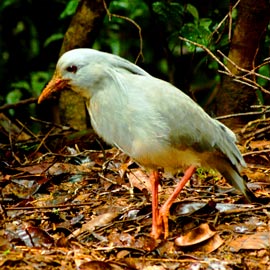
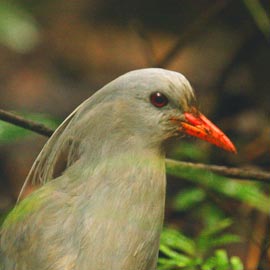 The reserve where the Kagus are (Parc Riviere Bleu) is normally closed on a Monday, thanks
to Yves we were allowed access and had it to ourselves. The plan was to get everybody in one spot and tape-lure a bird once, a particular individual has a
territory adjacent to the track and has become quite habituated to humans. However, the plan was "thwarted" by another bird which appeared at the side of the
track when only half the group had arrived, and proceeded to wander in and out of the forest edge. Thankfully it was still behaving thus when the rest arrived
twenty minutes later! The habituated bird had obviously had its beak put out of joint by this, and refused to appear, doing so only very briefly at the end of
the tape session. Several other birds were seen however, including one ridiculously tame individual feeding across the track as people began to walk back to
the vehicle. A lucky few, including me, managed to see birds displaying when a second one arrived at this spot.
New Caledonia has a number of endemics, most of which could be seen in two days, but you would need to be extremely lucky, plus April is not the best time of
year. Despite the constant rain (it was worse on the second day) most were seen by most, if not all, of our group. These included one of the most difficult,
Crow Honeyeater, the largest Honeyeater in the world, N.C. Myzomela, N.C.Goshawk,
N.C. Imperial Pigeon, N.C. Parakeet, Cloven-feathered Dove and
N.C. Crow. among others.
Unfortunately our time on the island was marred by news of a tsunami which had caused serious damage and loss of life on the islands we were due to visit next,
in the Solomons group. I don't propose to dwell on this except to say that future trips will probably visit Gizo and Koolambangara, the two islands we had to
miss, we still were able to land at Guadalcanal for some excellent birding. We said goodbye to New Caledonia just after lunch on our second day, and the rain
stopped almost immediately! Birds were much the same as before our visit, another controversial Polynesian Storm-petrel was called.
The reserve where the Kagus are (Parc Riviere Bleu) is normally closed on a Monday, thanks
to Yves we were allowed access and had it to ourselves. The plan was to get everybody in one spot and tape-lure a bird once, a particular individual has a
territory adjacent to the track and has become quite habituated to humans. However, the plan was "thwarted" by another bird which appeared at the side of the
track when only half the group had arrived, and proceeded to wander in and out of the forest edge. Thankfully it was still behaving thus when the rest arrived
twenty minutes later! The habituated bird had obviously had its beak put out of joint by this, and refused to appear, doing so only very briefly at the end of
the tape session. Several other birds were seen however, including one ridiculously tame individual feeding across the track as people began to walk back to
the vehicle. A lucky few, including me, managed to see birds displaying when a second one arrived at this spot.
New Caledonia has a number of endemics, most of which could be seen in two days, but you would need to be extremely lucky, plus April is not the best time of
year. Despite the constant rain (it was worse on the second day) most were seen by most, if not all, of our group. These included one of the most difficult,
Crow Honeyeater, the largest Honeyeater in the world, N.C. Myzomela, N.C.Goshawk,
N.C. Imperial Pigeon, N.C. Parakeet, Cloven-feathered Dove and
N.C. Crow. among others.
Unfortunately our time on the island was marred by news of a tsunami which had caused serious damage and loss of life on the islands we were due to visit next,
in the Solomons group. I don't propose to dwell on this except to say that future trips will probably visit Gizo and Koolambangara, the two islands we had to
miss, we still were able to land at Guadalcanal for some excellent birding. We said goodbye to New Caledonia just after lunch on our second day, and the rain
stopped almost immediately! Birds were much the same as before our visit, another controversial Polynesian Storm-petrel was called.
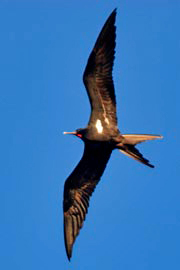 Just off the North-west tip of New Caledonia by morning (it's a big island), we woke to a hot, humid day and more Tahiti Petrels. A new bird appeared in the
morning, in the shape of Lesser Frigatebird, and a White-necked Petrel which was to be our last of the trip.
Lunch came and went, most people had still not had decent views of the big stormie,
despite a morning chumming session. Birds were getting very infrequent, but we decided to try putting down a couple more fish-oil slicks. We were distracted
by a distant flock but thankfully turned back to our slick after about 15 minutes, and suddenly there was a Polynesian Storm-petrel right in front of the bows!
Of course, having seen one, a classic "pied morph", more were to follow, although usually fairly distant. Later we came across a large whale carcass which
was attracting numbers of birds, and apparently two sharks. One of these was obviously dominant and in view much more often, it was fairly certainly a
Tiger Shark. There was also another "trip-tick", a Long-tailed Skua.
The next two days were spent at sea on the way to Rennell Island, part of the Solomons but somewhat isolated and different to others, quite a long way to the
south of the main groups. Approaching the tropics, seabird numbers lessen, particularly away from land, and this is unfortunately one of the downsides to this
trip. Unlike the Southern oceans, birds are spread over a vast area, and it is possible to sail for a day or more without seeing a bird, so the later stages
of the voyage can be somewhat boring. Having said that, most of the target species are very difficult to see anywhere else, so needs must!
The two days before Rennell proved fairly quiet, but several nice birds were seen, including White-tailed Tropicbirds, Lesser Frigatebird, Providence and
Kermadec Petrels and two more Polynesian Storm-petrels. Sooty Tern was the most numerous species, mainly fairly distant, whilst Arctic Skua
was the only new one. A couple of cetaceans caused a stir, a Spinner Dolphin and a quite close pod of beaked whales. These latter,
in common with many of their group, stayed mainly submerged, but were thought to be either Longman's or
Tropical Bottlenose, (which may be the same species anyway, so little is known of them).
Temperatures were rising by now and flying fish began to appear, a Red-footed Booby roosted overnight on the ship.
Just off the North-west tip of New Caledonia by morning (it's a big island), we woke to a hot, humid day and more Tahiti Petrels. A new bird appeared in the
morning, in the shape of Lesser Frigatebird, and a White-necked Petrel which was to be our last of the trip.
Lunch came and went, most people had still not had decent views of the big stormie,
despite a morning chumming session. Birds were getting very infrequent, but we decided to try putting down a couple more fish-oil slicks. We were distracted
by a distant flock but thankfully turned back to our slick after about 15 minutes, and suddenly there was a Polynesian Storm-petrel right in front of the bows!
Of course, having seen one, a classic "pied morph", more were to follow, although usually fairly distant. Later we came across a large whale carcass which
was attracting numbers of birds, and apparently two sharks. One of these was obviously dominant and in view much more often, it was fairly certainly a
Tiger Shark. There was also another "trip-tick", a Long-tailed Skua.
The next two days were spent at sea on the way to Rennell Island, part of the Solomons but somewhat isolated and different to others, quite a long way to the
south of the main groups. Approaching the tropics, seabird numbers lessen, particularly away from land, and this is unfortunately one of the downsides to this
trip. Unlike the Southern oceans, birds are spread over a vast area, and it is possible to sail for a day or more without seeing a bird, so the later stages
of the voyage can be somewhat boring. Having said that, most of the target species are very difficult to see anywhere else, so needs must!
The two days before Rennell proved fairly quiet, but several nice birds were seen, including White-tailed Tropicbirds, Lesser Frigatebird, Providence and
Kermadec Petrels and two more Polynesian Storm-petrels. Sooty Tern was the most numerous species, mainly fairly distant, whilst Arctic Skua
was the only new one. A couple of cetaceans caused a stir, a Spinner Dolphin and a quite close pod of beaked whales. These latter,
in common with many of their group, stayed mainly submerged, but were thought to be either Longman's or
Tropical Bottlenose, (which may be the same species anyway, so little is known of them).
Temperatures were rising by now and flying fish began to appear, a Red-footed Booby roosted overnight on the ship.
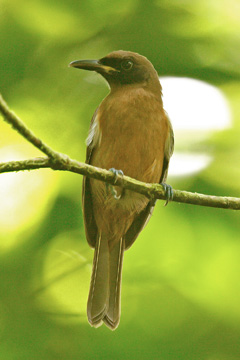 Arriving at Rennell overnight, we were greeted with a forested atoll, and soon after breakfast were landing on the beach. A steep path took us up to the
village, whose inhabitants were to provide us with lunch. This was a special occasion for them, we were the first passenger ship to land for over twenty
years! The lunch was superb, and villagers came out with coconuts (for drinks) as we returned from our birding walks, up to half a mile from the village.
Most people saw Cardinal Myzomelas on the walk up to the village, we went to look for the endemics almost immediately, and
everybody caught up with all five in the morning, Rennell Shrikebill, Rennell Fantail, Rennell Starling, and
Rennell and Bare-eyed White-eyes. The Starling is nomadic and can be problematic, none were seen on Chris' recce. trip in this area.
Quite a few other species were seen, not all by everyone, as we split into groups fairly quickly. The most noteworthy were probably the huge
Moustached Treeswift, Finsch's Pygmy Parrot (probably the smallest parrot in the world, about the size of
a sparrow, and Island Thrush. Other birds may be potential splits, the Australasian Ibis, Collared Kingfisher
and Fan-tailed Gerygone. The only big problem on Rennell was the heat and humidity, despite drinking plenty my hands started to
swell, a sign of dehydration and the only occasion I have ever experienced it. This rather marred an otherwise excellent day, and it was an exhausted
but happy group
that returned to the ship to sail towards the main Solomon group.
Arriving at Rennell overnight, we were greeted with a forested atoll, and soon after breakfast were landing on the beach. A steep path took us up to the
village, whose inhabitants were to provide us with lunch. This was a special occasion for them, we were the first passenger ship to land for over twenty
years! The lunch was superb, and villagers came out with coconuts (for drinks) as we returned from our birding walks, up to half a mile from the village.
Most people saw Cardinal Myzomelas on the walk up to the village, we went to look for the endemics almost immediately, and
everybody caught up with all five in the morning, Rennell Shrikebill, Rennell Fantail, Rennell Starling, and
Rennell and Bare-eyed White-eyes. The Starling is nomadic and can be problematic, none were seen on Chris' recce. trip in this area.
Quite a few other species were seen, not all by everyone, as we split into groups fairly quickly. The most noteworthy were probably the huge
Moustached Treeswift, Finsch's Pygmy Parrot (probably the smallest parrot in the world, about the size of
a sparrow, and Island Thrush. Other birds may be potential splits, the Australasian Ibis, Collared Kingfisher
and Fan-tailed Gerygone. The only big problem on Rennell was the heat and humidity, despite drinking plenty my hands started to
swell, a sign of dehydration and the only occasion I have ever experienced it. This rather marred an otherwise excellent day, and it was an exhausted
but happy group
that returned to the ship to sail towards the main Solomon group.
 The following morning saw us sailing along the coast of Guadalcanal en route for its capital, Honiara. Still extremely hot, the birds still not in
huge numbers, but we only had till late afternoon when the ship would be docking. One new species for the trip was Bridled Tern,
which tends to be less pelagic than Sooty, plus a small flock of Audubon's-type shearwaters was seen distantly. As everyone seemed to want to adopt the
recent taxonomic ideas which suggest seven or so new species from the old Audubon's/Little complex, specific identification of these birds was not confirmed.
Our island itinerary having been altered somewhat due to the tsunami, two trips to Mount Austin, just outside Honiara, were arranged, one that afternoon
and a second the following morning. A good number of widely varying species were seen, many endemics, from Midget Flowerpecker
to Blyth's Hornbill. These included several Parrots, Pigeons and a couple of Goshawks, plus Monarchs, Cuckoo-shrikes, the huge
Buff-headed Coucal and Ultramarine Kingfisher.
This last caused the first ever Solomon Islands twitch, as it was a target for many, and the group had split up. Thankfully there were several radios
around, and soon most people were converging from up to a kilometre away to see the bird, which sat quietly out in the open. Some even ran, since the
altitude made the conditions far less humid than on Rennell.
We were resigned to missing a few birds due to our change of itinerary, but one which was particularly galling was the endemic, endangered
Sea-eagle. Chris had a nest staked-out on Koolambangra, which made it worse. However, as we drove back to the ship a raptor soared ahead of the bus.
Several people realised its identity at the same time- a Solomon Sea Eagle! Panic started among those on the side of the bus that
hadn't seen it, but it veered back and proceeded to circle above us long enough for everyone to get out, and even set up tripods and 'scope it.
Needless to say, I added it to my collection of photos. Thirty minutes later we were back on board, talk about brinkmanship!
The following morning saw us sailing along the coast of Guadalcanal en route for its capital, Honiara. Still extremely hot, the birds still not in
huge numbers, but we only had till late afternoon when the ship would be docking. One new species for the trip was Bridled Tern,
which tends to be less pelagic than Sooty, plus a small flock of Audubon's-type shearwaters was seen distantly. As everyone seemed to want to adopt the
recent taxonomic ideas which suggest seven or so new species from the old Audubon's/Little complex, specific identification of these birds was not confirmed.
Our island itinerary having been altered somewhat due to the tsunami, two trips to Mount Austin, just outside Honiara, were arranged, one that afternoon
and a second the following morning. A good number of widely varying species were seen, many endemics, from Midget Flowerpecker
to Blyth's Hornbill. These included several Parrots, Pigeons and a couple of Goshawks, plus Monarchs, Cuckoo-shrikes, the huge
Buff-headed Coucal and Ultramarine Kingfisher.
This last caused the first ever Solomon Islands twitch, as it was a target for many, and the group had split up. Thankfully there were several radios
around, and soon most people were converging from up to a kilometre away to see the bird, which sat quietly out in the open. Some even ran, since the
altitude made the conditions far less humid than on Rennell.
We were resigned to missing a few birds due to our change of itinerary, but one which was particularly galling was the endemic, endangered
Sea-eagle. Chris had a nest staked-out on Koolambangra, which made it worse. However, as we drove back to the ship a raptor soared ahead of the bus.
Several people realised its identity at the same time- a Solomon Sea Eagle! Panic started among those on the side of the bus that
hadn't seen it, but it veered back and proceeded to circle above us long enough for everyone to get out, and even set up tripods and 'scope it.
Needless to say, I added it to my collection of photos. Thirty minutes later we were back on board, talk about brinkmanship!
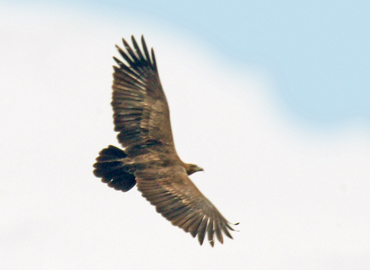 We awoke to another hot tropical day, so hot that the ship's air conditioning was unable to cope, but it wasn't too unpleasant on the bridge with the
windows open, ten knots doesn't create much of a breeze but it helps. Birdwise most of the day was quiet, with nothing new and most birds fairly distant.
One or two new cetaceans were seen, a group of Risso's Dolphins quite close and several distant Dwarf Sperm Whales.
A number of beaked whales were also seen, not well enough to clinch identification, but thought to probably be Blainville's.
About an hour before dusk the mood was suddenly changed from slightly bored to one of high elation; a feeding flock of Noddies and Boobies was seen, and
as we drew closer we could see a small shearwater circling beneath the flockand landing on the water. As we approached it became apparent that it was largely
dark, and could only be a Heinroth's Shearwater! So few records of this species, especially at sea, and there was one right in
front of us! The flock was dispersing rapidly at the ship's approach, and the shearwater did the same. Rodney was called to the bridge and we
attempted to chase it! Fortunately, although we never got really close, the bird zigzagged around somewhat and was in view long enough for everyone to see
the salient ID features. Several people even managed to get record shots, myself included, good enough to see the long thin bill and the white area on the
underwings.The following four days were in many ways a repeat of the last, and this was to be the pattern of the voyage until nearing Japanese waters.
We had planned landings at the Carolines and Northern Marianas, but unfortunately the latter are under United States administration and it became clear that
our Russian-registered vessel was not welcome without a considerable amount of security "red tape", so this location was removed from the itinerary, both
for this and subsequent voyages. This meant only one more landing before our final destination, and things did get pretty boring at times. Many hardened
birders were seen playing scrabble, among other activities. However, there were periods of excitement, the most notable of which was the sighting of a
probable Beck's Petrel. Even more mythical than Heinroth's Shearwater, the problem was that the only thing anybody knew about them
was that they looked like a Tahiti Petrel but 15% smaller. Hardly an identification criterion given that views were distant,
although this was a much better candidate than the previous "possible", and everyone was called to the deck to see it by two excited leaders.
Obviously much controversy
ensued, especially as the bird was flying with a Noddy and looked smaller, with an apparently different jizz to a Tahiti. A rarities committee wouldn't
have even considered it! Despite this several people thought that it probably was one, on balance, and just recently the species has been rediscovered
by Hadoram Shirihai, not a million miles from the area we were in. Hopefully future voyages may positively nail one.
Earlier in the day up to seven more Heinroth's Shearwaters were seen , but all more distantly than our first sighting, these two episodes apart interest
was mainly centred around cetaceans. New for the trip were Rough-toothed Dolphins and False Killer Whales.
We awoke to another hot tropical day, so hot that the ship's air conditioning was unable to cope, but it wasn't too unpleasant on the bridge with the
windows open, ten knots doesn't create much of a breeze but it helps. Birdwise most of the day was quiet, with nothing new and most birds fairly distant.
One or two new cetaceans were seen, a group of Risso's Dolphins quite close and several distant Dwarf Sperm Whales.
A number of beaked whales were also seen, not well enough to clinch identification, but thought to probably be Blainville's.
About an hour before dusk the mood was suddenly changed from slightly bored to one of high elation; a feeding flock of Noddies and Boobies was seen, and
as we drew closer we could see a small shearwater circling beneath the flockand landing on the water. As we approached it became apparent that it was largely
dark, and could only be a Heinroth's Shearwater! So few records of this species, especially at sea, and there was one right in
front of us! The flock was dispersing rapidly at the ship's approach, and the shearwater did the same. Rodney was called to the bridge and we
attempted to chase it! Fortunately, although we never got really close, the bird zigzagged around somewhat and was in view long enough for everyone to see
the salient ID features. Several people even managed to get record shots, myself included, good enough to see the long thin bill and the white area on the
underwings.The following four days were in many ways a repeat of the last, and this was to be the pattern of the voyage until nearing Japanese waters.
We had planned landings at the Carolines and Northern Marianas, but unfortunately the latter are under United States administration and it became clear that
our Russian-registered vessel was not welcome without a considerable amount of security "red tape", so this location was removed from the itinerary, both
for this and subsequent voyages. This meant only one more landing before our final destination, and things did get pretty boring at times. Many hardened
birders were seen playing scrabble, among other activities. However, there were periods of excitement, the most notable of which was the sighting of a
probable Beck's Petrel. Even more mythical than Heinroth's Shearwater, the problem was that the only thing anybody knew about them
was that they looked like a Tahiti Petrel but 15% smaller. Hardly an identification criterion given that views were distant,
although this was a much better candidate than the previous "possible", and everyone was called to the deck to see it by two excited leaders.
Obviously much controversy
ensued, especially as the bird was flying with a Noddy and looked smaller, with an apparently different jizz to a Tahiti. A rarities committee wouldn't
have even considered it! Despite this several people thought that it probably was one, on balance, and just recently the species has been rediscovered
by Hadoram Shirihai, not a million miles from the area we were in. Hopefully future voyages may positively nail one.
Earlier in the day up to seven more Heinroth's Shearwaters were seen , but all more distantly than our first sighting, these two episodes apart interest
was mainly centred around cetaceans. New for the trip were Rough-toothed Dolphins and False Killer Whales.
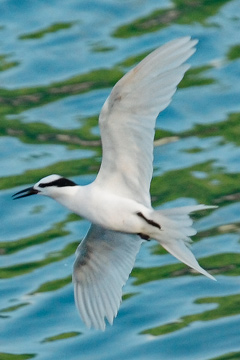
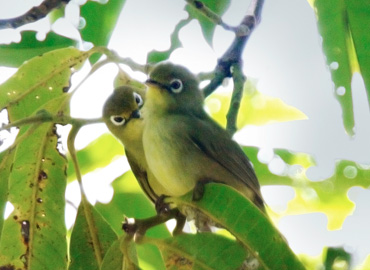 The next five days were again fairly quiet and hot, and included the crossing of the equator. This event wasn't a tick for everyone by any means,
but most enjoyed the associated champagne! Other than that few highlights, a few more new cetaceans included
Striped and Pantropical Spotted Dolphins and probable
Pygmy Sperm Whales whilst a very distant Omura's Whale was seen. This is a possible split from Bryde's,
but unfortunately views were hardly satisfactory. Although birds were thin on the sea a few new species were recorded for
the trip, these included our first definite
Grey-backed Terns , claims of which had been made and refuted on several occasions previously. A bird finally came close enough to be
photographed, but the species remained generally very scarce. South Polar Skua was also new, a pale bird on migration. The remaining
three new birds are all on the British List, but I don't think many people have actually seen Bulwer's Petrel in British waters! The
other two were Red-necked Phalarope and Leach's Petrel. Other birds included Wedge-tailed Shearwaters, the
pale phase was now beginning to predominate, several White-tailed Tropicbirds and single Kermadec and Tahiti Petrels. Pterodromas had all but run out, no more
until we were in Japanese waters, terns, noddies and boobies the main fare. Approaching Chuuk (Truk) Island on our sixth day at sea, a new seabird
finally appeared, assuming acceptance of the new taxonomy, in the shape of Tropical Shearwater (a split from Audubon's), a small
flock being seen as we negotiated the gap in the outer reef. White and Crested Terns were also much in evidence, and a small party of
Bottlenose Dolphins as we came to anchor. A further new species was seen, Black-naped Terns,
unfortunately fairly distant. Due to the necessity for pilotage we did not arrive in time to land that day, but an
early breakfast allowed us to get going on the endemics early the next. There aren't actually that many species on the island, the highlight was a nesting pair
of Caroline Island Ground-doves, (high in a tree!) which we hadn't expected to find. The low point, for some, was spending a considerable
amount of time and energy in temperatures up to 90 degrees, on what became known as the "Truk Death March". This was to dip, twice in some people's case, on Truk
Monarch, a highly endangered species that Chris had seen on his recce trip. Never mind- it's a passerine! Other birds on the island were fairly readily seen
including Caroline White-eye, Reed warbler and Swiftlet, Micronesian Starling
and Myzomela, Oceanic Flycatcher and Crimson-crowned Fruit-dove. More familiar were
Rufous Night Heron, Eastern Reef Heron and Pacific Golden Plover. White-tailed
Tropicbirds and White Terns were flying around most of the time, sharing the air with huge diurnal Caroline Fruit Bats
which are apparently an endemic species. We returned to the ship in the late afternoon, and whilst waiting for customs clearance to set sail, were
treated to much better views of Black-naped Terns, fishing in the harbour right next to the ship!
The next five days were again fairly quiet and hot, and included the crossing of the equator. This event wasn't a tick for everyone by any means,
but most enjoyed the associated champagne! Other than that few highlights, a few more new cetaceans included
Striped and Pantropical Spotted Dolphins and probable
Pygmy Sperm Whales whilst a very distant Omura's Whale was seen. This is a possible split from Bryde's,
but unfortunately views were hardly satisfactory. Although birds were thin on the sea a few new species were recorded for
the trip, these included our first definite
Grey-backed Terns , claims of which had been made and refuted on several occasions previously. A bird finally came close enough to be
photographed, but the species remained generally very scarce. South Polar Skua was also new, a pale bird on migration. The remaining
three new birds are all on the British List, but I don't think many people have actually seen Bulwer's Petrel in British waters! The
other two were Red-necked Phalarope and Leach's Petrel. Other birds included Wedge-tailed Shearwaters, the
pale phase was now beginning to predominate, several White-tailed Tropicbirds and single Kermadec and Tahiti Petrels. Pterodromas had all but run out, no more
until we were in Japanese waters, terns, noddies and boobies the main fare. Approaching Chuuk (Truk) Island on our sixth day at sea, a new seabird
finally appeared, assuming acceptance of the new taxonomy, in the shape of Tropical Shearwater (a split from Audubon's), a small
flock being seen as we negotiated the gap in the outer reef. White and Crested Terns were also much in evidence, and a small party of
Bottlenose Dolphins as we came to anchor. A further new species was seen, Black-naped Terns,
unfortunately fairly distant. Due to the necessity for pilotage we did not arrive in time to land that day, but an
early breakfast allowed us to get going on the endemics early the next. There aren't actually that many species on the island, the highlight was a nesting pair
of Caroline Island Ground-doves, (high in a tree!) which we hadn't expected to find. The low point, for some, was spending a considerable
amount of time and energy in temperatures up to 90 degrees, on what became known as the "Truk Death March". This was to dip, twice in some people's case, on Truk
Monarch, a highly endangered species that Chris had seen on his recce trip. Never mind- it's a passerine! Other birds on the island were fairly readily seen
including Caroline White-eye, Reed warbler and Swiftlet, Micronesian Starling
and Myzomela, Oceanic Flycatcher and Crimson-crowned Fruit-dove. More familiar were
Rufous Night Heron, Eastern Reef Heron and Pacific Golden Plover. White-tailed
Tropicbirds and White Terns were flying around most of the time, sharing the air with huge diurnal Caroline Fruit Bats
which are apparently an endemic species. We returned to the ship in the late afternoon, and whilst waiting for customs clearance to set sail, were
treated to much better views of Black-naped Terns, fishing in the harbour right next to the ship!
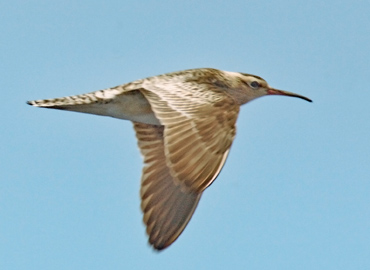 Having been denied access to the Marianas we now faced the prospect of ten days at sea before making landfall at our final destination, Kagoshima, on the
island of Kyushu. However during this time we were to approach as closely as possible Torishima Island, home of the Short-tailed Albatross, one of our
main target species. As close as possible meant twelve miles, due to Japanese regulations, so nothing was assured. I hear that subsequent voyages may be
able to approach more closely, and may land in the Bonin Islands, but landing on Torishima is absolutely forbidden. Things didn't start too well, in the
first three hours after dawn three birds were seen, none close enough to identify!
However towards the end of the first day a new species was sighted which was eventually to be following in the ship's wake in large numbers,
probably attracted by the constant drip of fish-oil which Chris and Dick had rigged up. This was Matsudaira's Storm-petrel,
although initial identification was a little delayed, since the two salient features in the guides, the forked tail and the white shafts to the primary
bases, are often not visible at sea. In addition the bird has a different jizz to most stormies we are used to, large and very long winged, indeed our
initial sighting was thought to be a Bulwer's Petrel. The only other thing of note in these lean days was a Whale Shark, a Red-footed
Booby circling the ship and catching flying fish disturbed by the bow wave in mid-air, and a slow increase in numbers of Matsudaira's at the stern. On the
fourth day, approaching the limit of the Tropics, things started to liven up. A pod of False Killer Whales passed very close to
the ship before breakfast, more birds started to appear especially pale phase Wedge-tailed Shearwaters, and a feeding flock of noddies and boobies had with it
yet another new bird for the trip, Bannerman's Shearwater, another recent split from Audubon's. As we continued north we began to see a
few migrating birds such as Barn Swallows, but one of the first of these was in fact something no-one expected- a
Little Whimbrel! This bird circled the ship for over an hour on and off, giving amazing views. Other migrating birds included
Long-tailed and Pomarine Skuas, but more was to come. Just before lunch a pair of Bryde's Whales were seen briefly logging on the
surface, boredom was officially cancelled! Unfortunately the weather started to deteriorate, and by late afternoon many people were down in their
cabins when Dick's voice called over the tannoy, in some exasperation it seemed, that three Bonin's Petrels had now been seen!
Suddenly the bridge and upper decks were full despite the ship rolling and spray coming over the sides, and a further three birds soon appeared.
Other birds included Short-tailed Shearwaters and a close Bannerman's Shearwater.
Having been denied access to the Marianas we now faced the prospect of ten days at sea before making landfall at our final destination, Kagoshima, on the
island of Kyushu. However during this time we were to approach as closely as possible Torishima Island, home of the Short-tailed Albatross, one of our
main target species. As close as possible meant twelve miles, due to Japanese regulations, so nothing was assured. I hear that subsequent voyages may be
able to approach more closely, and may land in the Bonin Islands, but landing on Torishima is absolutely forbidden. Things didn't start too well, in the
first three hours after dawn three birds were seen, none close enough to identify!
However towards the end of the first day a new species was sighted which was eventually to be following in the ship's wake in large numbers,
probably attracted by the constant drip of fish-oil which Chris and Dick had rigged up. This was Matsudaira's Storm-petrel,
although initial identification was a little delayed, since the two salient features in the guides, the forked tail and the white shafts to the primary
bases, are often not visible at sea. In addition the bird has a different jizz to most stormies we are used to, large and very long winged, indeed our
initial sighting was thought to be a Bulwer's Petrel. The only other thing of note in these lean days was a Whale Shark, a Red-footed
Booby circling the ship and catching flying fish disturbed by the bow wave in mid-air, and a slow increase in numbers of Matsudaira's at the stern. On the
fourth day, approaching the limit of the Tropics, things started to liven up. A pod of False Killer Whales passed very close to
the ship before breakfast, more birds started to appear especially pale phase Wedge-tailed Shearwaters, and a feeding flock of noddies and boobies had with it
yet another new bird for the trip, Bannerman's Shearwater, another recent split from Audubon's. As we continued north we began to see a
few migrating birds such as Barn Swallows, but one of the first of these was in fact something no-one expected- a
Little Whimbrel! This bird circled the ship for over an hour on and off, giving amazing views. Other migrating birds included
Long-tailed and Pomarine Skuas, but more was to come. Just before lunch a pair of Bryde's Whales were seen briefly logging on the
surface, boredom was officially cancelled! Unfortunately the weather started to deteriorate, and by late afternoon many people were down in their
cabins when Dick's voice called over the tannoy, in some exasperation it seemed, that three Bonin's Petrels had now been seen!
Suddenly the bridge and upper decks were full despite the ship rolling and spray coming over the sides, and a further three birds soon appeared.
Other birds included Short-tailed Shearwaters and a close Bannerman's Shearwater.
 The next day the ship was still in heavy seas, and due to cross the Tropic of Cancer in the afternoon. No less than 10,000 Short-tailed Shearwaters
were seen migrating north throughout the day, more Bannerman's, up to thirteen Matsudaira's behind us, and Wilson's and Leach's Storm-petrels. Migrating
waders were represented by a Pacific Golden Plover, and a Barn Swallow spent all day with us, eventually perching up for the night and allowing itself
to be hand-fed on flies! Highlight of the day was yet another new species, a tick for many people, Streaked Shearwater. This bird
has a fairly restricted range for a seabird, in an area which few birders visit (vagrants excepted). By the following day the wind had dropped although
there was still a heavy swell, but it was now raining. However this did help to give some of the best seabirding of the trip as birds were approaching
closely in the reduced visibility. We were in area off the breeding islands of both Bonin Petrel and Matsudaira's Storm-petrel, so numbers were high all
morning, along with a few more Bannermann's Shearwaters and Leach's Storm-petrels. "Another day, another species" continued to be our motto, as in among
the storm-petrels we began to identify Tristram's Storm-petrel. Very similar to Matsudaira's, most people were finally happy
when one flew the length of the ship, about ten metres out! However our record was slightly disrupted in that we saw a second new species that day, as
we spent most of the afternoon with the Bonin Islands in sight to starboard, Black-footed Albatross was not unexpected, it was
interesting that we hadn't seen any further south, however.
The next day the ship was still in heavy seas, and due to cross the Tropic of Cancer in the afternoon. No less than 10,000 Short-tailed Shearwaters
were seen migrating north throughout the day, more Bannerman's, up to thirteen Matsudaira's behind us, and Wilson's and Leach's Storm-petrels. Migrating
waders were represented by a Pacific Golden Plover, and a Barn Swallow spent all day with us, eventually perching up for the night and allowing itself
to be hand-fed on flies! Highlight of the day was yet another new species, a tick for many people, Streaked Shearwater. This bird
has a fairly restricted range for a seabird, in an area which few birders visit (vagrants excepted). By the following day the wind had dropped although
there was still a heavy swell, but it was now raining. However this did help to give some of the best seabirding of the trip as birds were approaching
closely in the reduced visibility. We were in area off the breeding islands of both Bonin Petrel and Matsudaira's Storm-petrel, so numbers were high all
morning, along with a few more Bannermann's Shearwaters and Leach's Storm-petrels. "Another day, another species" continued to be our motto, as in among
the storm-petrels we began to identify Tristram's Storm-petrel. Very similar to Matsudaira's, most people were finally happy
when one flew the length of the ship, about ten metres out! However our record was slightly disrupted in that we saw a second new species that day, as
we spent most of the afternoon with the Bonin Islands in sight to starboard, Black-footed Albatross was not unexpected, it was
interesting that we hadn't seen any further south, however.
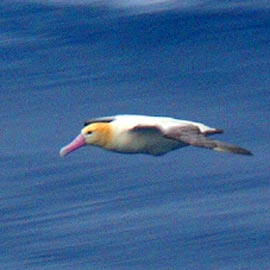 The weather had cleared in the afternoon, and we awoke to calm seas and sunshine on what was to be the BIG day, when we passed Torishima Island on the
lookout for that Albatross. The morning saw more of yesterday's species, also Pantropical Spotted Dolphins and False Killer
Whales and more Black-footed Albatrosses.
We expected to be in position mid-afternoon, as indeed we were, although by then the weather had deteriorated and we were back to rolling around in
not very good visibility. As we
approached the area chumming was intensified, resulting in large numbers of birds behind us, Black-foots, Wedge-tailed and the odd Short-tailed and
Streaked Shearwater, plus up to seventy Matsudaira's. Most eyes however were on more distant horizons, and after what seemed like ages a call went out-
"two distant white-backed Albatrosses!" Distant was actually a understatement, Chris did incredibly well to pick them out, and unfortunately not
everyone was able to get on them. Soon however one approached out of the mist and flew down the side towards the stern- an adult
Short-tailed Albatross! Luckily my familiarity with these ships meant I knew a short-cut from the bridge to the rear of the upper deck, this
ensured I was at the front of the rapidly assembled crowd, and by dint of wedging myself against a rail to counteract the ship's motion I was able to
get some just about acceptable shots as the bird of the trip flew back and forth across the stern! Regrettably this species, unlike most Albatrosses, does
not tend to follow ships, so a few minutes was all we got, but that was enough to get it on everyone's list, and you can't get much better than a breeding
adult. Two more birds, one an immature, were seen
just before dusk, although most people were already in the bar celebrating. Future trips will probably spend more time in the area, so hopefully will see
more. Although this species is being seen more frequently in the Eastern Pacific off the USA and especially Alaska, the birds in question are usually
immatures and you will need to spend a lot of time at sea to see one, unless you are extremely lucky.
The weather had cleared in the afternoon, and we awoke to calm seas and sunshine on what was to be the BIG day, when we passed Torishima Island on the
lookout for that Albatross. The morning saw more of yesterday's species, also Pantropical Spotted Dolphins and False Killer
Whales and more Black-footed Albatrosses.
We expected to be in position mid-afternoon, as indeed we were, although by then the weather had deteriorated and we were back to rolling around in
not very good visibility. As we
approached the area chumming was intensified, resulting in large numbers of birds behind us, Black-foots, Wedge-tailed and the odd Short-tailed and
Streaked Shearwater, plus up to seventy Matsudaira's. Most eyes however were on more distant horizons, and after what seemed like ages a call went out-
"two distant white-backed Albatrosses!" Distant was actually a understatement, Chris did incredibly well to pick them out, and unfortunately not
everyone was able to get on them. Soon however one approached out of the mist and flew down the side towards the stern- an adult
Short-tailed Albatross! Luckily my familiarity with these ships meant I knew a short-cut from the bridge to the rear of the upper deck, this
ensured I was at the front of the rapidly assembled crowd, and by dint of wedging myself against a rail to counteract the ship's motion I was able to
get some just about acceptable shots as the bird of the trip flew back and forth across the stern! Regrettably this species, unlike most Albatrosses, does
not tend to follow ships, so a few minutes was all we got, but that was enough to get it on everyone's list, and you can't get much better than a breeding
adult. Two more birds, one an immature, were seen
just before dusk, although most people were already in the bar celebrating. Future trips will probably spend more time in the area, so hopefully will see
more. Although this species is being seen more frequently in the Eastern Pacific off the USA and especially Alaska, the birds in question are usually
immatures and you will need to spend a lot of time at sea to see one, unless you are extremely lucky.
 After our excitement, the next three days were
going to be an-anticlimax, although not quite so much as we thought. The weather calmed on the first morning and fewer seabirds were in evidence, many
of the ship followers had disappeared, although the Matsudaira's were still present in much-reduced numbers. Try as we might we could not find a Swinhoe's
Storm-petrel, which had been expected, and we had seen our last Albatrosses and Bonin Petrels. Numbers of migrating Long-tailed and Pomarine Skuas were up
and we began to see some quite large flocks of Streaked Shearwaters, although they tend to be boat-shy so we never got really close for long. Most other
seabirds had been left behind in the tropics, and the focus of attention turned to migrants which landed on or circled the boat, mainly on the second and
third days. More Barn Swallows landed whilst our hand-fed bird was with us until the morning of the last day at sea, when it flew off South(!??), a
Red-rumped Swallow joined them briefly in the air, whilst other highlights included Black-faced Bunting,
Siberian Rubythroat, Chestnut-eared Starlings on the top mast, and as we approached land, six
Blue-and-white Flycatchers and a Narcissus Flycatcher. Non-passerines were also well represented, a
Striated Heron which followed us for a while, Intermediate and Cattle egrets,
one of which landed on the ship's rail, and a Pacific Goldie which arrived exhausted on the first night and was definitely ship assisted since it
spent two days in someone's cabin. It had to be smuggled ashore in Japan to await its fate, but at least it was a bit perkier and stood a chance by the
time we arrived. Other waders were in evidence too, Grey Phalaropes, Grey-tailed Tattlers, and Terek and
Wood Sandpipers. Marine creatures were represented by a Scalloped Hammerhead Shark, two
Sperm Whales, and a pod of Risso's Dolphins, our last cetacean sighting.
The fourth day saw us docking at Kagoshima harbour, ending a superb trip which seemed to come up with all the hoped-for seabird species almost on cue at
every stage. However, there is an Auk in these waters which many had hoped to see, although I personally did not think we would, and I was proved right.
However, a few of us, having travelled so far and who should have been eager to return home, had already made plans which saw us ticking
Japanese Crested Murrelet the following day, not far from where we docked. This is obviously well worth a few extra days, and could even be done in
less, but we wanted to hire a fishing boat and go out into the harbour where the birds are to be found. This tour round Biro Island has been incorporated
into later trips by Wildwings. After our excitement, the next three days were
going to be an-anticlimax, although not quite so much as we thought. The weather calmed on the first morning and fewer seabirds were in evidence, many
of the ship followers had disappeared, although the Matsudaira's were still present in much-reduced numbers. Try as we might we could not find a Swinhoe's
Storm-petrel, which had been expected, and we had seen our last Albatrosses and Bonin Petrels. Numbers of migrating Long-tailed and Pomarine Skuas were up
and we began to see some quite large flocks of Streaked Shearwaters, although they tend to be boat-shy so we never got really close for long. Most other
seabirds had been left behind in the tropics, and the focus of attention turned to migrants which landed on or circled the boat, mainly on the second and
third days. More Barn Swallows landed whilst our hand-fed bird was with us until the morning of the last day at sea, when it flew off South(!??), a
Red-rumped Swallow joined them briefly in the air, whilst other highlights included Black-faced Bunting,
Siberian Rubythroat, Chestnut-eared Starlings on the top mast, and as we approached land, six
Blue-and-white Flycatchers and a Narcissus Flycatcher. Non-passerines were also well represented, a
Striated Heron which followed us for a while, Intermediate and Cattle egrets,
one of which landed on the ship's rail, and a Pacific Goldie which arrived exhausted on the first night and was definitely ship assisted since it
spent two days in someone's cabin. It had to be smuggled ashore in Japan to await its fate, but at least it was a bit perkier and stood a chance by the
time we arrived. Other waders were in evidence too, Grey Phalaropes, Grey-tailed Tattlers, and Terek and
Wood Sandpipers. Marine creatures were represented by a Scalloped Hammerhead Shark, two
Sperm Whales, and a pod of Risso's Dolphins, our last cetacean sighting.
The fourth day saw us docking at Kagoshima harbour, ending a superb trip which seemed to come up with all the hoped-for seabird species almost on cue at
every stage. However, there is an Auk in these waters which many had hoped to see, although I personally did not think we would, and I was proved right.
However, a few of us, having travelled so far and who should have been eager to return home, had already made plans which saw us ticking
Japanese Crested Murrelet the following day, not far from where we docked. This is obviously well worth a few extra days, and could even be done in
less, but we wanted to hire a fishing boat and go out into the harbour where the birds are to be found. This tour round Biro Island has been incorporated
into later trips by Wildwings.
|












